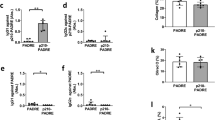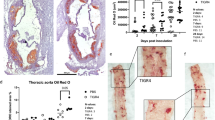Abstract
During the progression of atherosclerosis, autoantibodies are induced to epitopes of oxidized low-density lipoprotein (oxLDL) and active immunization of hypercholesterolemic mice with oxLDL ameliorates atherogenesis. We unexpectedly found that many autoantibodies to oxLDL derived from 'naive' atherosclerotic mice share complete genetic and structural identity with antibodies from the classic anti-phosphorylcholine B-cell clone, T15, which protect against common infectious pathogens, including pneumococci. To investigate whether in vivo exposure to pneumococci can affect atherogenesis, we immunized Ldlr−/− mice with Streptococcus pneumoniae. This induced high circulating levels of oxLDL-specific IgM and a persistent expansion of oxLDL-specific T15 IgM-secreting B cells primarily in the spleen, which were cross-reactive with pneumococcal determinants. Pneumococcal immunization decreased the extent of atherosclerosis, and plasma from these mice had an enhanced capacity to block the binding of oxLDL to macrophages. These studies show molecular mimicry between epitopes of oxLDL and S. pneumoniae and indicate that these immune responses can have beneficial effects.
This is a preview of subscription content, access via your institution
Access options
Subscribe to this journal
Receive 12 print issues and online access
$209.00 per year
only $17.42 per issue
Buy this article
- Purchase on SpringerLink
- Instant access to full article PDF
Prices may be subject to local taxes which are calculated during checkout





Similar content being viewed by others
References
Glass, C.K. & Witztum, J.L. Atherosclerosis. The road ahead. Cell 104, 503–516 (2001).
Libby, P., Ridker, P.M. & Maseri, A. Inflammation and atherosclerosis. Circulation 105, 1135–1143 (2002).
Binder, C.J. et al. Innate and acquired immunity in atherogenesis. Nat. Med. 8, 1218–1226 (2002).
Hansson, G.K., Libby, P., Schonbeck, U. & Yan, Z.Q. Innate and adaptive immunity in the pathogenesis of atherosclerosis. Circ. Res. 91, 281–291 (2002).
Hansson, G.K. Immune mechanisms in atherosclerosis. Arterioscler. Thromb. Vasc. Biol. 21, 1876–1890 (2001).
Hörkkö, S. et al. Immunological responses to oxidized LDL. Free Radic. Biol. Med. 28, 1771–1779 (2000).
Watson, A.D. et al. Structural identification by mass spectrometry of oxidized phospholipids in minimally oxidized low density lipoprotein that induce monocyte/endothelial interactions and evidence for their presence in vivo. J. Biol. Chem. 272, 13597–13607 (1997).
Hörkkö, S. et al. Monoclonal autoantibodies specific for oxidized phospholipids or oxidized phospholipid-protein adducts inhibit macrophage uptake of oxidized low-density lipoproteins. J. Clin. Invest. 103, 117–128 (1999).
Palinski, W. et al. Antisera and monoclonal antibodies specific for epitopes generated during oxidative modification of low density lipoprotein. Arteriosclerosis 10, 325–335 (1990).
Palinski, W. et al. Cloning of monoclonal autoantibodies to epitopes of oxidized lipoproteins from apolipoprotein E-deficient mice. Demonstration of epitopes of oxidized low density lipoprotein in human plasma. J. Clin. Invest. 98, 800–814 (1996).
Chang, M.K., Binder, C.J., Torzewski, M. & Witztum, J.L. C-reactive protein binds to both oxidized LDL and apoptotic cells through recognition of a common ligand: Phosphorylcholine of oxidized phospholipids. Proc. Natl. Acad. Sci. USA 99, 13043–13048 (2002).
Friedman, P., Hörkkö, S., Steinberg, D., Witztum, J.L. & Dennis, E.A. Correlation of antiphospholipid antibody recognition with the structure of synthetic oxidized phospholipids. Importance of Schiff base formation and aldol concentration. J. Biol. Chem. 277, 7010–7020 (2002).
Shaw, P.X. et al. Natural antibodies with the T15 idiotype may act in atherosclerosis, apoptotic clearance, and protective immunity. J. Clin. Invest. 105, 1731–1740 (2000).
Chang, M.K. et al. Monoclonal antibodies against oxidized low-density lipoprotein bind to apoptotic cells and inhibit their phagocytosis by elicited macrophages: evidence that oxidation-specific epitopes mediate macrophage recognition. Proc. Natl. Acad. Sci. USA 96, 6353–6358 (1999).
Briles, D.E., Forman, C., Hudak, S. & Claflin, J.L. Anti-phosphorylcholine antibodies of the T15 idiotype are optimally protective against Streptococcus pneumoniae. J. Exp. Med. 156, 1177–1185 (1982).
Mi, Q.S. et al. Highly reduced protection against Streptococcus pneumoniae after deletion of a single heavy chain gene in mouse. Proc. Natl. Acad. Sci. USA 97, 6031–6036 (2000).
Snapper, C.M. et al. Distinct types of T-cell help for the induction of a humoral immune response to Streptococcus pneumoniae. Trends Immunol. 22, 308–311 (2001).
Kearney, J.F., Barletta, R., Quan, Z.S. & Quintans, J. Monoclonal vs. heterogeneous anti-H-8 antibodies in the analysis of the anti-phosphorylcholine response in BALB/c mice. Eur. J. Immunol. 11, 877–883 (1981).
Kenny, J.J. et al. Antigen binding and idiotype analysis of antibodies obtained after electroporation of heavy and light chain genes encoding phosphocholine-specific antibodies: a model for T15-idiotype dominance. J. Exp. Med. 176, 1637–1643 (1992).
Desaymard, C., Giusti, A.M. & Scharff, M.D. Rat anti-T15 monoclonal antibodies with specificity for VH- and VH-VL epitopes. Mol. Immunol. 21, 961–967 (1984).
Daugherty, A. et al. The effects of total lymphocyte deficiency on the extent of atherosclerosis in apolipoprotein E−/− mice. J. Clin. Invest. 100, 1575–1580 (1997).
Dansky, H.M., Charlton, S.A., Harper, M.M. & Smith. J.D. T and B lymphocytes play a minor role in atherosclerotic plaque formation in the apolipoprotein E-deficient mouse. Proc. Natl. Acad. Sci. USA 94, 4642–4646 (1997).
Palinski, W., Miller, E. & Witztum, J.L. Immunization of low density lipoprotein (LDL) receptor-deficient rabbits with homologous malondialdehyde-modified LDL reduces atherogenesis. Proc. Natl. Acad. Sci. USA 92, 821–825 (1995).
Freigang, S., Hörkkö, S., Miller, E., Witztum, J.L. & Palinski, W. Immunization of LDL receptor-deficient mice with homologous malondialdehyde-modified and native LDL reduces progression of atherosclerosis by mechanisms other than induction of high titers of antibodies to oxidative neoepitopes. Arterioscler. Thromb. Vasc. Biol. 18, 1972–1982 (1998).
Hansen, P.R. et al. Freunds adjuvant alone is antiatherogenic in apoE-deficient mice and specific immunization against TNFα confers no additional benefit. Atherosclerosis 158, 87–94 (2001).
Silverman, G.J. et al. A B cell superantigen-induced persistent “Hole” in the B-1 repertoire. J. Exp. Med. 192, 87–98 (2000).
Bendelac, A., Bonneville, M. & Kearney, J.F. Autoreactivity by design: innate B and T lymphocytes. Nat. Rev. Immunol. 1, 177–186 (2001).
Wardemann, H., Boehm, T., Dear, N. & Carsetti, R. B-1a B cells that link the innate and adaptive immune responses are lacking in the absence of the spleen. J. Exp. Med. 195, 771–780 (2002).
Caligiuri, G., Nicoletti, A., Poirier, B. & Hansson, G.K. Protective immunity against atherosclerosis carried by B cells of hypercholesterolemic mice. J. Clin. Invest. 109, 745–753 (2002).
Masmoudi, H., Mota-Santos, T., Huetz, F., Coutinho, A. & Cazenave, P.A. All T15 Id-positive antibodies (but not the majority of VHT15+ antibodies) are produced by peritoneal CD5+ B lymphocytes. Int. Immunol. 2, 515–520 (1990).
Berland, R. & Wortis, H.H. Origins and functions of B-1 cells with notes on the role of CD5. Annu. Rev. Immunol. 20, 253–300 (2002).
Silverman, G.J. et al. Neo-self antigens and the expansion of B-1 cells: lessons from atherosclerosis-prone mice. Curr. Top. Microbiol. Immunol. 252, 189–200 (2000).
Macpherson, A.J. et al. A primitive T cell-independent mechanism of intestinal mucosal IgA responses to commensal bacteria. Science 288, 2222–2226 (2000).
Ochsenbein, A.F. et al. Control of early viral and bacterial distribution and disease by natural antibodies. Science 286, 2156–2159 (1999).
Martin, F., Oliver, A.M. & Kearney, J.F. Marginal zone and B1 B cells unite in the early response against T-independent blood-borne particulate antigens. Immunity 14, 617–629 (2001).
Reid, R.R. et al. Endotoxin shock in antibody-deficient mice: unraveling the role of natural antibody and complement in the clearance of lipopolysaccharide. J. Immunol. 159, 970–975 (1997).
Gillotte-Taylor, K., Boullier, A., Witztum, J.L., Steinberg, D. & Quehenberger, O. Scavenger receptor class B type I as a receptor for oxidized low density lipoprotein. J. Lipid Res. 42, 1474–1482 (2001).
Boullier, A. et al. The binding of oxidized low density lipoprotein to mouse CD36 is mediated in part by oxidized phospholipids that are associated with both the lipid and protein moieties of the lipoprotein. J. Biol. Chem. 275, 9163–9169 (2000).
Halpern, R., Kaveri, S.V. & Kohler, H. Human anti-phosphorylcholine antibodies share idiotopes and are self-binding. J. Clin. Invest. 88, 476–482 (1991).
Brown, M., Schiffman, G. & Rittenberg, M.B. Subpopulations of antibodies to phosphocholine in human serum. J. Immunol. 132, 1323–1328 (1984).
Schenkein, H.A. et al. Phosphorylcholine-dependent cross-reactivity between dental plaque bacteria and oxidized low-density lipoproteins. Infect. Immun. 69, 6612–6617 (2001).
Hörkkö, S., Miller, E., Branch, D.W., Palinski, W. & Witztum, J.L. The epitopes for some antiphospholipid antibodies are adducts of oxidized phospholipid and β2 glycoprotein 1 (and other proteins). Proc. Natl. Acad. Sci. USA 94, 10356–10361 (1997).
Silverman, G.J. et al. The dual phases of the response to neonatal exposure to a VH family-restricted staphylococcal B cell superantigen. J. Immunol. 161, 5720–5732 (1998).
Miller, Y.I. et al. Minimally modified LDL binds to CD14, induces macrophage spreading via TLR4/MD-2 and inhibits phagocytosis of apoptotic cells. J. Biol. Chem. 278, 1561–1568 (2003).
Tangirala, R.K., Rubin, E.M. & Palinski, W. Quantitation of atherosclerosis in murine models: correlation between lesions in the aortic origin and in the entire aorta, and differences in the extent of lesions between sexes in LDL receptor-deficient and apolipoprotein E-deficient mice. J. Lipid Res. 36, 2320–2328 (1995).
Acknowledgements
We thank A. Kesäniemi and M. Leinonen(University of Oulu, Finland) for provision of human samples and F. Casanada, D. Dwyer, J. Juliano, E. Miller, J. Pattison and M. Silvestre for technical assistance. This work was supported by National Institutes of Health grants HL56989 (SCOR in Molecular Medicine and Atherosclerosis), HL6946, HL57505, AI40305 and the UCSD Rheumatic Disease Core Center (P30 AR47360). C.J.B. was supported by a Ph.D. scholarship from the Boehringer Ingelheim Fonds and a scholarship from the Austrian Academy of Science; E.K. was a recipient of a summer undergraduate research fellowship from the medical scientist training program at UCSD and a student investigator grant from the Stein Institute for Research in Aging. The laboratories of G.J.S., W.P. and J.L.W. contributed equally to this work.
Author information
Authors and Affiliations
Corresponding author
Ethics declarations
Competing interests
The authors declare no competing financial interests.
Rights and permissions
About this article
Cite this article
Binder, C., Hörkkö, S., Dewan, A. et al. Pneumococcal vaccination decreases atherosclerotic lesion formation: molecular mimicry between Streptococcus pneumoniae and oxidized LDL. Nat Med 9, 736–743 (2003). https://doi.org/10.1038/nm876
Received:
Accepted:
Published:
Issue Date:
DOI: https://doi.org/10.1038/nm876
This article is cited by
-
Impact of influenza, herpes zoster, and pneumococcal vaccinations on the incidence of cardiovascular events in subjects aged over 65 years: a systematic review
GeroScience (2023)
-
Hypertension and Dyslipidemia: the Two Partners in Endothelium-Related Crime
Current Atherosclerosis Reports (2023)
-
Human circulating CD24hi marginal zone B cells produce IgM targeting atherogenic antigens and confer protection from vascular disease
Nature Cardiovascular Research (2023)
-
Antibodies in action: the role of humoral immunity in the fight against atherosclerosis
Immunity & Ageing (2022)
-
The why and how of adaptive immune responses in ischemic cardiovascular disease
Nature Cardiovascular Research (2022)



